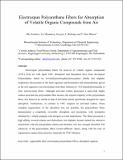| dc.contributor.author | Scholten, Elke | |
| dc.contributor.author | Bromberg, Lev E. | |
| dc.contributor.author | Rutledge, Gregory C. | |
| dc.contributor.author | Hatton, T. Alan | |
| dc.date.accessioned | 2013-10-02T19:12:44Z | |
| dc.date.available | 2013-10-02T19:12:44Z | |
| dc.date.issued | 2011-10 | |
| dc.date.submitted | 2011-06 | |
| dc.identifier.issn | 1944-8244 | |
| dc.identifier.issn | 1944-8252 | |
| dc.identifier.uri | http://hdl.handle.net/1721.1/81271 | |
| dc.description.abstract | Electrospun polyurethane fibers for removal of volatile organic compounds (VOC) from air with rapid VOC absorption and desorption have been developed. Polyurethanes based on 4,4-methylenebis(phenylisocyanate) (MDI) and aliphatic isophorone diisocyanate as the hard segments and butanediol and tetramethylene glycol as the soft segments were electrospun from their solutions in N,N-dimethylformamide to form micrometer-sized fibers. Although activated carbon possessed a many-fold higher surface area than the polyurethane fiber meshes, the sorption capacity of the polyurethane fibers was found to be similar to that of activated carbon specifically designed for vapor adsorption. Furthermore, in contrast to VOC sorption on activated carbon, where complete regeneration of the adsorbent was not possible, the polyurethane fibers demonstrated a completely reversible absorption and desorption, with desorption obtained by a simple purging with nitrogen at room temperature. The fibers possessed a high affinity toward toluene and chloroform, but aliphatic hexane lacked the necessary strong attractive interactions with the polyurethane chains and therefore was less strongly absorbed. The selectivity of the polyurethane fibers toward different vapors, along with the ease of regeneration, makes them attractive materials for VOC filtration. | en_US |
| dc.description.sponsorship | Boeing Company | en_US |
| dc.description.sponsorship | Netherlands Organisation for Scientific Research (NWO) (Talent Scholarship) | en_US |
| dc.language.iso | en_US | |
| dc.publisher | American Chemical Society | en_US |
| dc.relation.isversionof | http://dx.doi.org/10.1021/am200748y | en_US |
| dc.rights | Creative Commons Attribution-Noncommercial-Share Alike 3.0 | en_US |
| dc.rights.uri | http://creativecommons.org/licenses/by-nc-sa/3.0/ | en_US |
| dc.source | Prof. Rutledge Via Erja Kajosalo | en_US |
| dc.title | Electrospun Polyurethane Fibers for Absorption of Volatile Organic Compounds from Air | en_US |
| dc.type | Article | en_US |
| dc.identifier.citation | Scholten, Elke, Lev Bromberg, Gregory C. Rutledge, and T. Alan Hatton 2011Electrospun Polyurethane Fibers for Absorption of Volatile Organic Compounds from Air. ACS Applied Materials & Interfaces 3(10): 3902–3909. | en_US |
| dc.contributor.department | Massachusetts Institute of Technology. Department of Chemical Engineering | en_US |
| dc.contributor.approver | Rutledge, Gregory C. | en_US |
| dc.contributor.mitauthor | Rutledge, Gregory C. | en_US |
| dc.contributor.mitauthor | Bromberg, Lev E. | en_US |
| dc.contributor.mitauthor | Hatton, T. Alan | en_US |
| dc.contributor.mitauthor | Scholten, Elke | en_US |
| dc.relation.journal | ACS Applied Materials & Interfaces | en_US |
| dc.eprint.version | Author's final manuscript | en_US |
| dc.type.uri | http://purl.org/eprint/type/JournalArticle | en_US |
| eprint.status | http://purl.org/eprint/status/PeerReviewed | en_US |
| dspace.orderedauthors | Scholten, Elke; Bromberg, Lev; Rutledge, Gregory C.; Hatton, T. Alan | en_US |
| dc.identifier.orcid | https://orcid.org/0000-0002-4558-245X | |
| dc.identifier.orcid | https://orcid.org/0000-0001-8137-1732 | |
| mit.license | OPEN_ACCESS_POLICY | en_US |
| mit.metadata.status | Complete | |
